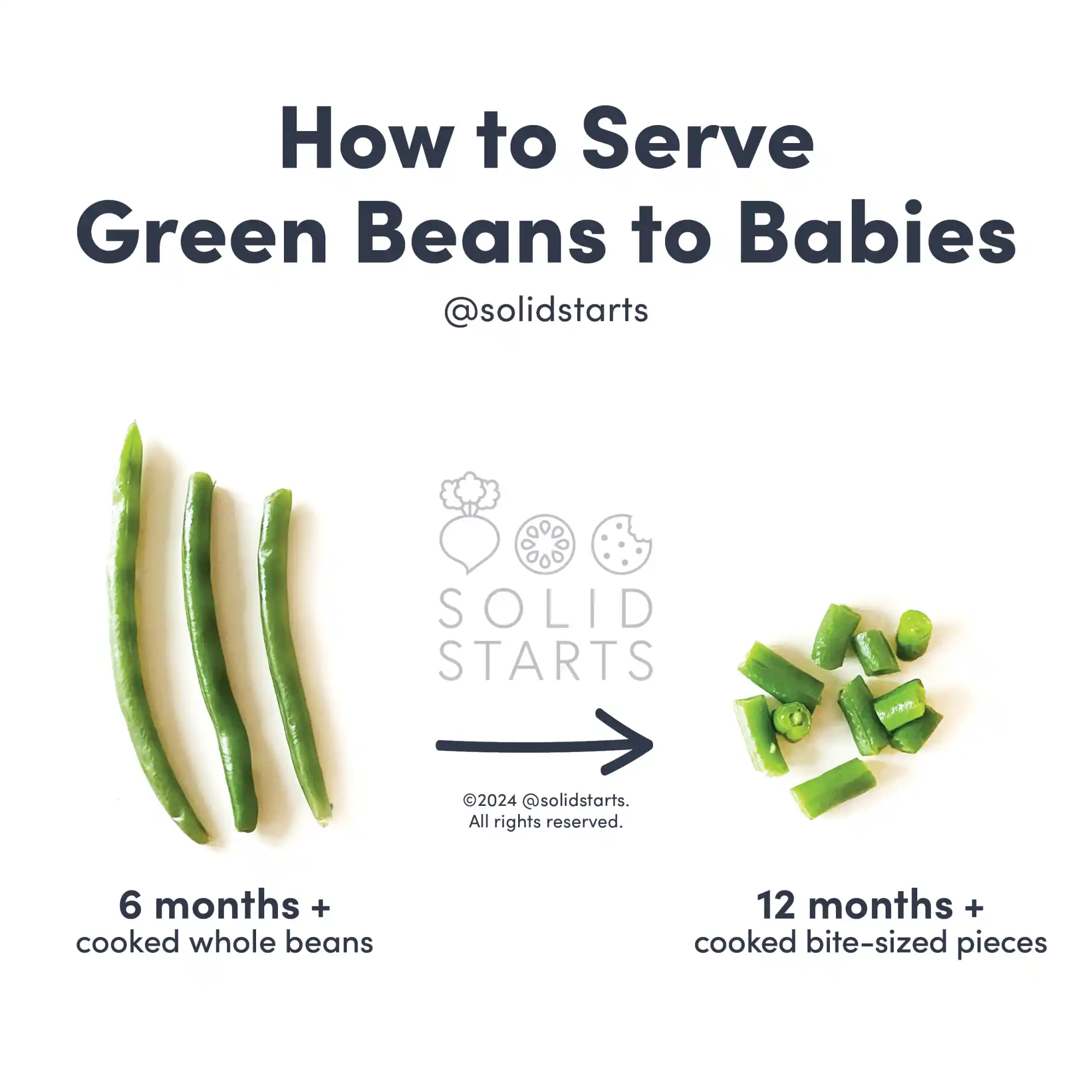Access our First Foods® Database in the Solid Starts App.
Learn moreGreen Beans
Legume
Age Suggestion
6 months
Iron-Rich
No
Common Allergen
No

When can babies have green beans or string beans?
Green beans, sometimes known as string beans, may be introduced as soon as baby is ready to start solids, which is generally around 6 months of age.
Green beans are snap beans—a sprawling family of legumes whose tender pods are eaten before their tiny seeds mature and swell from soaking up sun and water. Aside from green beans, there are bush beans, pole beans, string beans, and wax beans, to name a few. All trace back to the common bean that was cultivated by Indigenous people of Central and South America for thousands of years before colonizers took the seeds to Europe.
How do you serve green beans to babies?
Every baby develops on their own timeline, and the suggestions on how to cut or prepare particular foods are generalizations for a broad audience.
6 months old +:
Offer cooked green beans in their whole form (a whole bean, uncut is best). At this age, whole bean pods may be safer for babies than pre-cut green beans. Whole bean pods are also easier for the baby to grasp. As they munch, their gums smash the pod and reduce its roundness, while small pieces of pre-cut green beans could be more likely to be accidentally swallowed whole. If you’d like to work the fine motor skills required for utensils, raw green beans can be excellent “spoons” or vehicles to practice self-feeding a pureed texture (like hummus). While baby won’t consume the green bean itself when used this way (as raw green beans require strong jaw control and for most babies, teeth, to break through the skin), they are fantastic for learning the skills of scooping.
12 months old +:
Offer bite-sized pieces of cooked green beans. This is also a great time to practice with forks and green beans spear quite nicely!
18 months old +:
Continue to offer bite-sized pieces of cooked green beans as finger food or serve with a fork but reduce the cooking time to acclimate the child to chewing tougher foods. You can also serve whole green beans with a dip.


How to prepare green beans for babies 6 months +
How to prepare green beans for toddlers 12 months +
Videos
Are green beans a choking hazard for babies?
Yes. Green beans can be firm and, when cut into small sizes, are similar in size and shape to the trachea at this early stage in life, qualities that increase the risk of choking. To reduce the risk, prepare and serve green beans in an age-appropriate way as described in the How to Serve section. Worried about the small beans inside each pod? The act of munching on a green bean pod tends to smash and flatten the little beans inside, which decreases choking risk. You can also use the back of a fork to flatten the whole cooked green bean pod before offering to baby to further decrease the risk. As always, make sure you create a safe eating environment and stay within an arm’s reach of baby during meals.
Learn the signs of choking and gagging and more about choking first aid in our free guides, Infant Rescue and Toddler Rescue.
Are green beans a common allergen?
No. Green bean allergies are rare, though not unheard of. As you would when introducing any new food, start with a small amount at first and follow baby’s lead.
Are green beans healthy for babies?
Yes. Green beans are rich in fiber, folate, and water, in addition to vitamins B6, C, and K. Plus, they offer a dash of iron, some magnesium, lutein and zeaxanthin, as well as a variety of antioxidants. These nutrients work together to support baby’s gut microbiome, hydration, brain development, metabolic processes, iron absorption, immunity, blood clotting, red blood cells, vision, and more.
Do I need to worry about the nitrates in green beans?
No. Feel free to offer vegetables that contain nitrates (arugula, beets, cabbage, green beans, spinach, and squash to name a few) as part of a variety of foods in the diet. Nitrates are naturally-occurring compounds which, if consumed in excess, may negatively affect oxygen levels in the blood. That said, babies who are allowed to self-feed typically do not consume excessive amounts of solid food because they need lots of practice to learn how to eat it. Nitrates in vegetables are generally not a cause for concern, and the benefits of introducing these vegetables as part of a balanced diet typically outweigh the unlikely risk of excessive consumption.
To reduce nitrate exposure, avoid consumption of untested well water and take care with purees. When possible, avoid homemade purees made with higher nitrate vegetables that are stored for more than 24 hours and commercial purees not consumed within 24 hours of opening.
Our Team
Written by
Expert Tips Delivered to Your Inbox
Sign up for weekly tips, recipes and more!
Copyright © 2025 • Solid Starts Inc







